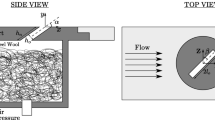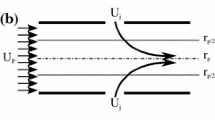Abstract
Non-circular jets, particularly elongated jets and jets with sharp corners, are of interest due to their enhanced large- and small-scale mixing and combustion stability. Non-circular jet geometries such as elliptic, triangular, rectangular, and square have been extensively studied. The non-uniform curvature and elongated design of elliptic and rectangular jets has been shown to facilitate axis switching. Additionally, jets with sharp corners have been shown to facilitate small-scale mixing and further vortex ring deformation, as has been observed in triangular, square, and rectangular jets. There are, however, currently no data on the flow characteristics of a jet that combines these two features, i.e., it enhances both large- and small-scale mixing. The jet is issuing from a nozzle shape defined by two arcs of a circle connecting at sharp corners in the shape of an eye (hereafter termed ‘lenticular’). The current study uses experimental techniques to characterize the lenticular jet and compare its behavior to previously studied circular and non-circular jets. Additionally, snapshot POD analysis was used to identify coherent structures and their dynamic features. The lenticular jet was found to have higher entrainment and stronger mixing than a traditional round jet, and comparable mixing and entrainment characteristics as previously studied non-circular jet geometries. It is particularly interesting to compare the jet behavior of the lenticular jet to an elliptic jet. The geometry of these two jets is extremely similar, the difference being sharp corners along the major axis of the lenticular jet. By comparing the lenticular jet and the elliptic jet, the effect of sharp corners, which have been shown to increase small-scale mixing and vortex ring deformation, can be observed. It was found that along the minor axis, where geometry was similar, shear layer turbulence intensity and spreading rate of the jets were also similar. Along the major axis, however, introducing corner features in the lenticular jet lowered the spread rate, resulted in a faster breakdown of turbulence in the shear layer, increased exit turbulence, and resulted in anisotropic centerline turbulence.
Graphic abstract
Geometry of a jet issuing from a novel exit shape defined by two arcs of a circle connecting at sharp corners. The exit shape has been termed lenticular and possesses characteristics known to increase both large- and small-scale mixing. The ensuing jet sharply contracts along the major axis and rapidly expands along the minor axis resulting in an axis switch.















Similar content being viewed by others
References
Grinstein FF (2001) Vortex dynamics and entrainment in rectangular free jets. J Fluid Mech. https://doi.org/10.1017/s0022112001004141
Grinstein FF, Devore CR (1996) Dynamics of coherent structures and transition to turbulence in free square jets. Phys Fluids 8(5):1237–1251. https://doi.org/10.1063/1.868895
Grinstein FF, Gutmark E, Parr T (1995) Near field dynamics of subsonic free square jets. A computational and experimental study. Phys Fluids 7(6):1483–1497. https://doi.org/10.1063/1.868534
Gutmark EJ, Grinstein FF (1999) Flow control with noncircular jets. Annu Rev Fluid Mech 31(1):239–272. https://doi.org/10.1146/annurev.fluid.31.1.239
Gutmark E, Schadow KC (1987) Flow characteristics of orifice and tapered jets. Phys Fluids 30(11):3448. https://doi.org/10.1063/1.866477
Gutmark E, Schadow KC, Parr TP, Hanson-Parr DM, Wilson KJ (1989) Noncircular jets in combustion systems. Exp Fluids 7(4):248–258. https://doi.org/10.1007/bf00198004
Gutmark E, Schadow KC, Wilson KJ (1991) Subsonic and supersonic combustion using noncircular injectors. J Propuls Power 7(2):240–249. https://doi.org/10.2514/3.23317
Ho C, Gutmark E (1987) Vortex induction and mass entrainment in a small-aspect-ratio elliptic jet. J Fluid Mech 179(1):383. https://doi.org/10.1017/s0022112087001587
Husain HS (1983) Controlled excitation of elliptic jets. Phys Fluids 26(10):2763. https://doi.org/10.1063/1.864062
Koshigoe S, Tubis A, Ho C (1988) Vortex deformation in elliptic-core jets from the perspective of linear instability analysis. Phys Fluids 31(9):2504–2517. https://doi.org/10.1063/1.866604
Koshigoe S, Gutmark E, Schadow KC, Tubis A (1989) Initial development of noncircular jets leading to axis switching. AIAA J 27(4):411–419. https://doi.org/10.2514/3.10128
Lumley JL, Holmes P, Berkooz G (1993) The proper orthogonal decomposition in the analysis of turbulent flows. Annu Rev Fluid Mech 25:539–575
Mi J, Nathan GJ (2009) Statistical properties of turbulent free jets issuing from nine differently-shaped nozzles. Flow Turbul Combust 84(4):583–606. https://doi.org/10.1007/s10494-009-9240-0
Mi J, Nathan GJ, Luxton RE (2000) Centreline mixing characteristics of jets from nine differently shaped nozzles. Exp Fluids 28(1):93–94. https://doi.org/10.1007/s003480050012
Quinn WR (1989) On mixing in an elliptic turbulent free jet. Phys Fluids A 1(10):1716–1722. https://doi.org/10.1063/1.857536
Quinn WR (1992a) Streamwise evolution of a square jet cross section. AIAA J 30(12):2852–2857. https://doi.org/10.2514/3.48973
Quinn W (1992b) Turbulent free jet flows issuing from sharp-edged rectangular slots: the influence of slot aspect ratio. Exp Therm Fluid Sci 5(2):203–215. https://doi.org/10.1016/0894-1777(92)90007-r
Quinn WR (2005) Measurements in the near flow field of an isosceles triangular turbulent free jet. Exp Fluids 39(1):111–126. https://doi.org/10.1007/s00348-005-0988-2
Quinn W (2006) Upstream nozzle shaping effects on near field flow in round turbulent free jets. Eur J Mech B/Fluids 25(3):279–301. https://doi.org/10.1016/j.euromechflu.2005.10.002
Quinn WR, Militzer J (1988) Experimental and numerical study of a turbulent free square jet. Phys Fluids 31(5):1017. https://doi.org/10.1063/1.867007
Schadow KC, Gutmark E, Parr DM, Wilson KJ (1988) Selective control of flow coherence in triangular jets. Exp Fluids 6(2):129–135. https://doi.org/10.1007/bf00196464
Sirovich L (1987) Turbulence and the dynamics of coherent structures. Part 1: coherent structures. Quart Appl Math XLV(3):561–571
Toyoda K, Okamoto T, Shirahama Y (1994) Eduction of vortical structures by pressure measurements in noncircular jets. Appl Sci Res 53(3–4):237–248. https://doi.org/10.1007/bf00849102
Wygnanski I, Fiedler H (1969) Some measurements in the self-preserving jet. J Fluid Mech 38(03):577. https://doi.org/10.1017/s0022112069000358
Xu G, Antonia R (2002) Effect of different initial conditions on a turbulent round free jet. Exp Fluids 33(5):677–683. https://doi.org/10.1007/s00348-002-0523-7
Xu M, Zhang J, Mi J, Nathan GJ, Kalt PA (2013) Mean and fluctuating velocity fields of a diamond turbulent jet. Chin Phys B 22(3):034701. https://doi.org/10.1088/1674-1056/22/3/034701
Xu M, Tong X, Yue D, Zhang J, Mi J, Nathan GJ, Kalt PAM (2014) Effect of noncircular orifice plates on the near flow field of turbulent free jets. Chin Phys B 23(12):124703. https://doi.org/10.1088/1674-1056/23/12/124703
Zhang HH, Chen ZH, Guo ZQ, Zheng C, Xue DW (2018) Numerical investigation on the three-dimensional flow characteristics of unsteady subsonic elliptic jet. Comput Fluids 160:78–92
Author information
Authors and Affiliations
Corresponding author
Additional information
Publisher's Note
Springer Nature remains neutral with regard to jurisdictional claims in published maps and institutional affiliations.
Electronic supplementary material
Below is the link to the electronic supplementary material.
Rights and permissions
About this article
Cite this article
Maddox, A., Gutmark, E. Experimental study of a lenticular jet. Exp Fluids 61, 95 (2020). https://doi.org/10.1007/s00348-020-2930-z
Received:
Revised:
Accepted:
Published:
DOI: https://doi.org/10.1007/s00348-020-2930-z




